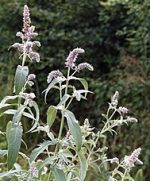 Also called wild mint, this herbaceous perennial is native to moist and wet habitats of Europe, western and central Asia, and southern and northern parts of Africa. Plants rapidly grow with a creeping rhizome to form colonies and have erect creeping stems that are square in cross section and 16-47″ tall. The strongly aromatic leave are stalkless, 2-4″ long, and oblong-elliptical to lanceolae. They are green to grayish green on top with white undersides and have sparsely toothed edges. In mid to late summer terminal spikes of small white to lilac or purple flowers appear. The spikes are branched, dense, and tapered. Horsemint is probably the mint mentioned in the Bible and is a tradtitional medicinal herb so deserves a place in the herb and Bible garden although its growth may need to be restricted. Mint is a member of the deadnettle family, Laminaceae, that also includes basil, sage, and beebalm. The genus name, Mentha, comes from the ancient Greek word μίνθη that honors Minthe, a nymph who was transformed into a mint plant. The specific epithet, longifolia, comes from the ancient Latin words longum meaning long and folium meaning leaf.
Also called wild mint, this herbaceous perennial is native to moist and wet habitats of Europe, western and central Asia, and southern and northern parts of Africa. Plants rapidly grow with a creeping rhizome to form colonies and have erect creeping stems that are square in cross section and 16-47″ tall. The strongly aromatic leave are stalkless, 2-4″ long, and oblong-elliptical to lanceolae. They are green to grayish green on top with white undersides and have sparsely toothed edges. In mid to late summer terminal spikes of small white to lilac or purple flowers appear. The spikes are branched, dense, and tapered. Horsemint is probably the mint mentioned in the Bible and is a tradtitional medicinal herb so deserves a place in the herb and Bible garden although its growth may need to be restricted. Mint is a member of the deadnettle family, Laminaceae, that also includes basil, sage, and beebalm. The genus name, Mentha, comes from the ancient Greek word μίνθη that honors Minthe, a nymph who was transformed into a mint plant. The specific epithet, longifolia, comes from the ancient Latin words longum meaning long and folium meaning leaf.
Type: Herbaceous perennial
Bloom:Dense, branched spike of small white to lilac or purple flowers in mid to late summer
Size: 16-47″ H and spreading
Light: Full sun to partial shade
Soil: Average, moist
Hardiness: Zones 6-9
Care: Confine to prevent unwanted spreading; cutback to encourage new growth
Pests and Diseases: Caterpillars, froghoppers, mint beetle, powdery mildew, mint rust.
Propagation: Cuttings, division
Companion Plants: Is said to protect cabbate and tomatoes from pests
Photo Credit: Wikipedia